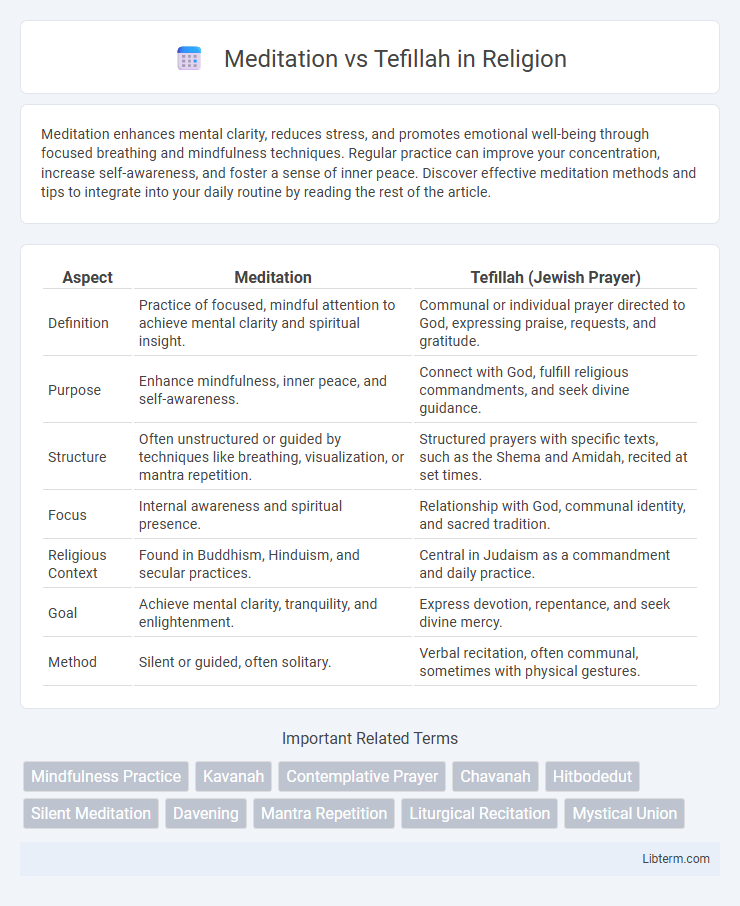Meditation enhances mental clarity, reduces stress, and promotes emotional well-being through focused breathing and mindfulness techniques. Regular practice can improve your concentration, increase self-awareness, and foster a sense of inner peace. Discover effective meditation methods and tips to integrate into your daily routine by reading the rest of the article.
Table of Comparison
| Aspect | Meditation | Tefillah (Jewish Prayer) |
|---|---|---|
| Definition | Practice of focused, mindful attention to achieve mental clarity and spiritual insight. | Communal or individual prayer directed to God, expressing praise, requests, and gratitude. |
| Purpose | Enhance mindfulness, inner peace, and self-awareness. | Connect with God, fulfill religious commandments, and seek divine guidance. |
| Structure | Often unstructured or guided by techniques like breathing, visualization, or mantra repetition. | Structured prayers with specific texts, such as the Shema and Amidah, recited at set times. |
| Focus | Internal awareness and spiritual presence. | Relationship with God, communal identity, and sacred tradition. |
| Religious Context | Found in Buddhism, Hinduism, and secular practices. | Central in Judaism as a commandment and daily practice. |
| Goal | Achieve mental clarity, tranquility, and enlightenment. | Express devotion, repentance, and seek divine mercy. |
| Method | Silent or guided, often solitary. | Verbal recitation, often communal, sometimes with physical gestures. |
Introduction to Meditation and Tefillah
Meditation involves focused mental exercises that cultivate mindfulness, awareness, and inner peace, often drawing from various spiritual and secular traditions worldwide. Tefillah, rooted in Jewish tradition, is a structured form of prayer that combines praise, petition, and gratitude directed toward God, fostering a deep spiritual connection. Both practices enhance self-awareness and intentionality but differ in their purposes, methods, and religious frameworks.
Defining Meditation: Origins and Practices
Meditation, rooted in ancient spiritual traditions such as Buddhism and Hinduism, involves focused mental exercises aimed at achieving heightened awareness or relaxation. Techniques include mindfulness, breath control, and visualization, designed to cultivate inner peace and self-awareness. Unlike Tefillah, which is a structured Jewish prayer emphasizing communication with God, meditation centers on personal mental discipline and introspection.
Understanding Tefillah: Jewish Prayer Explored
Tefillah, or Jewish prayer, differs from meditation in its structured, communal, and scriptural nature, emphasizing a direct dialogue with God through specific blessings and supplications. While meditation often involves silent, introspective focus aimed at inner peace, Tefillah integrates intention, worded prayers, and traditional rhythms to cultivate both spiritual connection and communal identity. Understanding Tefillah reveals its role as an active, intentional practice rooted in Jewish law and tradition, facilitating a conscious relationship with the Divine.
Differences in Purpose: Meditation vs. Tefillah
Meditation primarily aims to cultivate mindfulness, inner peace, and self-awareness by quieting the mind and focusing on breath or a specific object, fostering personal spiritual growth. Tefillah, or Jewish prayer, centers on expressing devotion, gratitude, and requests to God, emphasizing a relational and communal connection with the Divine. While meditation is often introspective and secular or spiritual in approach, tefillah is inherently theistic and structured around established liturgical practices.
Techniques: Mindfulness and Spiritual Dialogue
Meditation techniques emphasize mindfulness, cultivating present-moment awareness through focused breathing and sensory observation to achieve mental clarity and emotional balance. Tefillah, or Jewish prayer, centers on spiritual dialogue, engaging the individual in a heartfelt conversation with the Divine, often guided by traditional liturgy and intentional kavannah (focused intention). Both practices foster inner connection but differ in approach: meditation prioritizes nonjudgmental awareness while Tefillah emphasizes relational communication with God.
Psychological Benefits: Calm vs. Connection
Meditation cultivates psychological calm through regulated breathing and mindfulness, reducing stress and anxiety by activating the parasympathetic nervous system. Tefillah, or Jewish prayer, fosters a deep psychological connection by invoking spiritual presence and communal identity, enhancing emotional resilience and meaning. Both practices offer complementary benefits: meditation emphasizes inner tranquility while tefillah strengthens relational and divine connection, supporting holistic mental well-being.
Spiritual Dimensions: Personal Growth and Divine Relationship
Tefillah engages the individual in a direct dialogue with the Divine, fostering a profound connection through structured prayer and sacred language that nurtures spiritual growth and elevates personal sanctity. Meditation emphasizes inner stillness and self-awareness, cultivating mindfulness that enhances emotional balance and transcends the ego, leading to deeper personal transformation. Both practices enrich spiritual dimensions uniquely: Tefillah strengthens relational intimacy with God, while meditation develops self-mastery and conscious presence.
Cultural and Historical Contexts
Meditation and Tefillah serve distinct roles shaped by their cultural and historical contexts; meditation originates in Eastern spiritual traditions aimed at achieving mindfulness and inner peace, often practiced individually or in groups. Tefillah, rooted in Jewish religious history, is a structured form of prayer that fosters a communal connection to God through specific blessings and liturgical recitations. Both practices reflect their societies' unique approaches to spirituality, with meditation emphasizing personal enlightenment and Tefillah emphasizing covenantal relationship and communal identity.
Integrating Meditation and Tefillah: Complementary Practices
Integrating meditation and tefillah enhances spiritual focus by combining mindfulness techniques with traditional Jewish prayer, fostering deeper connection to the divine. Meditation's emphasis on breath control and mental clarity complements tefillah's structured blessings and intentions, enriching reflective states during prayer. Together, these practices cultivate holistic spiritual awareness, promoting emotional balance and intentionality in religious observance.
Conclusion: Choosing Your Path to Inner Peace
Meditation and Tefillah offer distinct pathways to inner peace, each rooted in unique spiritual traditions and practices. Meditation emphasizes mindfulness and self-awareness through silent reflection, while Tefillah fosters a personal connection with the Divine through prayer and intention. Choosing your path depends on whether you seek self-guided tranquility or a communal, faith-centered experience for spiritual growth.
Meditation Infographic

 libterm.com
libterm.com